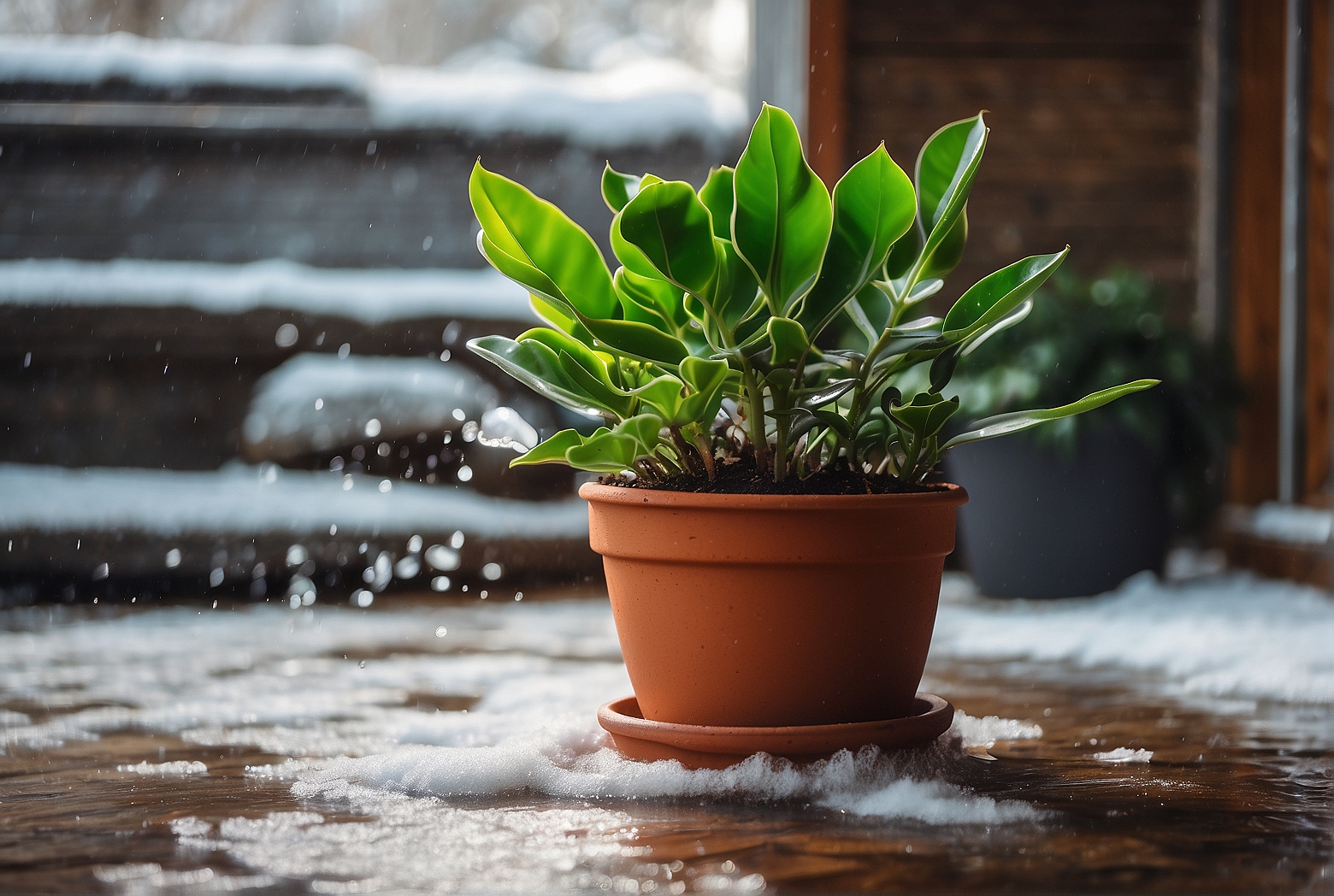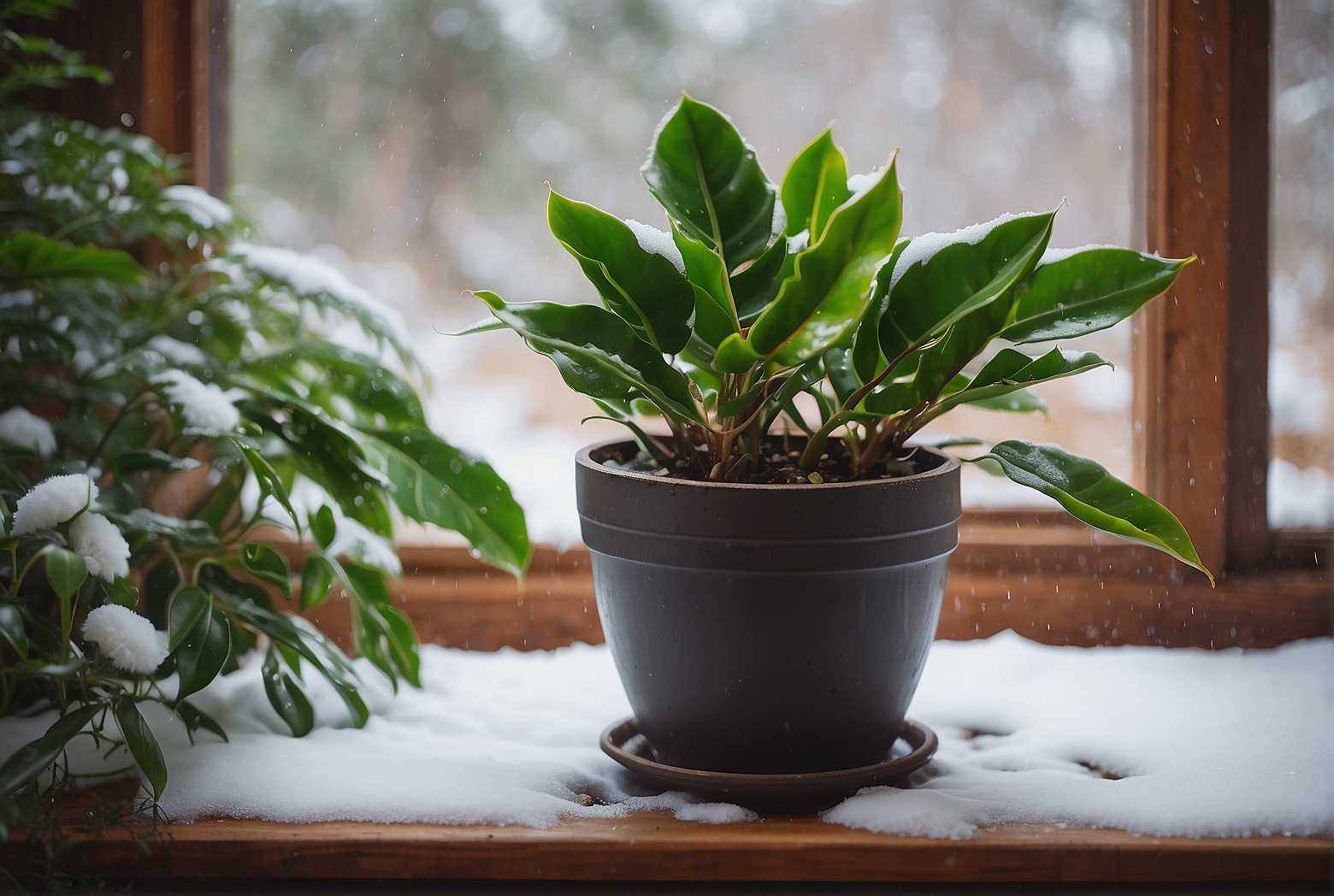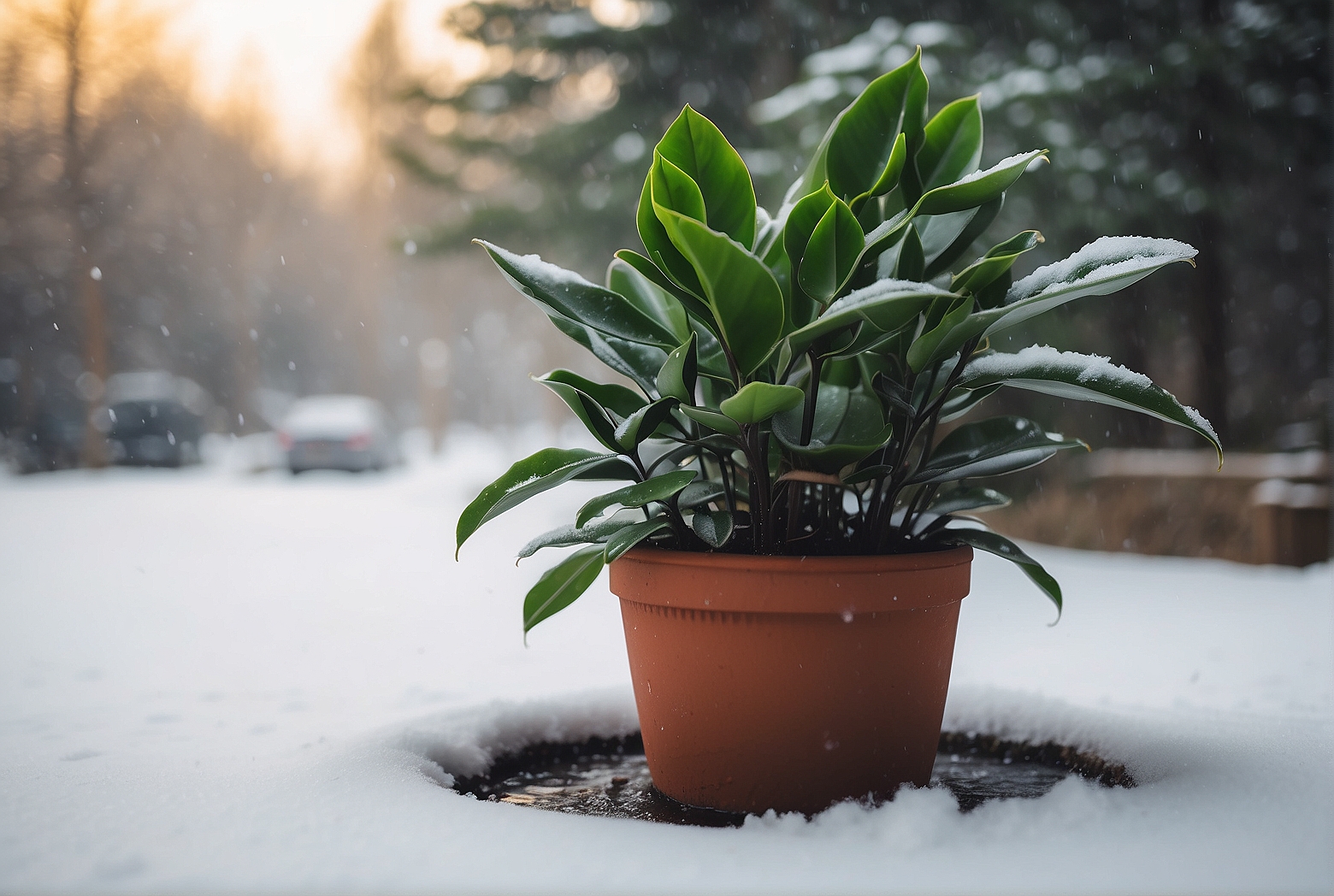Last Updated on April 12, 2024 by Tony Manhart
In the colder months, caring for your indoor plants requires a bit of adjustment, especially when it comes to watering your precious ZZ plant. As the temperature drops, it’s important to understand the proper watering routine to keep your ZZ plant healthy and thriving. In this article, discover the key tips and tricks to ensure your ZZ plant’s hydration needs are met throughout the winter season, ensuring it continues to flourish and bring a touch of green into your home.
Understanding the watering needs of ZZ plants
The importance of proper watering
Proper watering is vital for the health and well-being of ZZ plants. Water provides essential nutrients and hydration that are necessary for the plant’s growth and survival. However, watering the ZZ plant correctly can be a bit tricky, as overwatering or underwatering can lead to various issues such as root rot or dehydration.
Factors that influence watering requirements
Several factors influence the watering requirements of ZZ plants. One crucial aspect is the plant’s size and maturity. Smaller ZZ plants generally require less water compared to larger, more established ones. Environmental factors such as temperature and humidity also play a role. Higher temperatures and lower humidity levels may increase the plant’s water needs.
Adaptation of watering frequency during winter
During the winter months, ZZ plants experience a period of dormancy where they enter a reduced growth state. This dormancy affects their water needs, and watering frequency should be adjusted accordingly. Overwatering during this period can be detrimental to the plant’s health, as the reduced metabolic activity may hinder the uptake and utilization of excess water.

Determining the watering schedule
Assessing the soil moisture
One effective way to determine when to water your ZZ plant is by assessing the moisture level of the soil. Inserting your finger into the soil up to the knuckle will give you an idea of its moisture content. If the soil feels dry at this depth, it’s an indication that the plant needs watering.
Consideration of temperature and humidity
Temperature and humidity are critical factors to consider when establishing a watering schedule for your ZZ plant. Higher temperatures and drier conditions may require more frequent watering, while cooler temperatures and higher humidity levels may reduce the plant’s water requirements.
Observing the plant’s growth and health
Another factor to consider when determining the watering schedule is the plant’s growth and overall health. If the ZZ plant appears lush, with vibrant foliage and steady growth, it’s a sign that the current watering regimen is suitable. However, if the plant starts to show signs of wilting or drooping leaves, it may be an indication that it needs more water.
Watering techniques and best practices
Choosing the right watering method
There are various methods to water your ZZ plant, but it’s crucial to choose the one that suits your plant’s needs best. The most common approaches include using a watering can, a spray bottle, or bottom watering. Each method has its advantages and disadvantages, so it’s essential to consider factors such as the plant’s size, potting mix, and drainage capabilities.

Using well-draining containers and potting mix
To prevent water accumulation and the risk of root rot, it’s crucial to use well-draining containers for your ZZ plant. Opt for pots with drainage holes to allow excess water to escape. Additionally, using a well-draining potting mix, such as a combination of potting soil and perlite or sand, ensures adequate drainage and prevents waterlogged conditions.
Avoiding water accumulation in the bottom tray
When watering your ZZ plant, it’s crucial to avoid water accumulation in the bottom tray or saucer. Leaving excess water sitting in the tray can lead to stagnant water, which promotes the growth of harmful bacteria and fungi. Always empty the tray or saucer after watering to prevent waterlogged conditions.
Providing sufficient water without encouraging root rot
While it’s essential to provide sufficient water to your ZZ plant, it’s equally crucial to avoid overwatering. ZZ plants prefer slightly dry conditions, and overwatering can lead to root rot and other issues. Ensure that the soil is adequately moist but not excessively wet, and allow the top few inches to dry out between waterings.
Timing the watering sessions
Avoiding water stagnation
Timing your watering sessions is crucial to avoid water stagnation and the risk of root rot in your ZZ plant. Excessive moisture can hinder the plant’s ability to take up oxygen, leading to root suffocation. Watering in the early morning or during the day allows the excess water to evaporate, reducing the chances of waterlogged conditions.
Determining the right frequency
The frequency of watering your ZZ plant depends on various factors, including the plant’s size, pot size, environmental conditions, and the moisture retention properties of the potting mix. As a general guideline, it’s recommended to water ZZ plants every 1-2 weeks, allowing the soil to dry out partially between waterings. However, it’s essential to observe the plant and adjust the watering frequency accordingly.
The importance of consistency
Maintaining a consistent watering schedule is crucial for the health of your ZZ plant. Erratic watering habits can lead to stress on the plant, resulting in stunted growth, leaf discoloration, or wilting. Aim to establish a regular watering routine and stick to it, providing your ZZ plant with the consistent moisture it needs for optimal growth.
Signs of under-watering and over-watering
Identifying symptoms of dehydration
Under-watering can cause dehydration in ZZ plants, leading to wilted leaves, dry and brittle stems, and yellowing of foliage. The leaves may also become crispy or develop brown patches. If you notice these symptoms, it’s essential to increase your watering frequency and ensure the plant receives sufficient moisture.
Recognizing indications of excessive moisture
Over-watering can be just as harmful to your ZZ plant as under-watering. Some signs of excessive moisture include yellowing or wilting leaves, root rot, a foul smell emanating from the soil, and the presence of mold or fungus on the soil surface. If you notice any of these signs, it’s crucial to adjust your watering practices and allow the soil to dry out before the next watering session.
How to correct watering mistakes
If you’ve been under-watering or over-watering your ZZ plant, it’s not too late to correct the issue. For under-watered plants, ensure that you water more frequently and thoroughly, allowing the water to reach the root system. For over-watered plants, allow the soil to dry out completely before the next watering session and adjust your watering frequency accordingly. Removing any affected leaves or stems can also help promote healthy growth.
Watering considerations for different ZZ plant sizes
Watering young ZZ plants
Young ZZ plants often have smaller root systems and, as a result, require less water compared to their mature counterparts. It’s crucial to avoid overwatering young ZZ plants to prevent root rot and encourage healthy growth. Ensure that the soil is evenly moist but not saturated, and adjust watering frequency based on the plant’s needs and environmental conditions.
Caring for mature ZZ plants
As ZZ plants mature and develop larger root systems, their water requirements increase. Mature ZZ plants can tolerate slightly more moisture, but it’s still crucial to avoid overwatering. Allow the soil to partially dry out between waterings to prevent waterlogged conditions. Regularly check the soil moisture and adjust the watering schedule as needed.
Addressing watering needs of large ZZ plant specimens
Large ZZ plant specimens require special attention when it comes to watering. Due to their size, these plants can retain moisture longer, so it’s vital to ensure that the soil is adequately drained to avoid water accumulation. Consider using deep watering techniques to reach the ZZ plant’s extensive root system fully. Additionally, regular monitoring and adjustment of the watering schedule based on the plant’s needs and environmental conditions are essential.
Choosing the right water source
Tap water vs. filtered water
When it comes to selecting a water source for your ZZ plant, both tap water and filtered water can be suitable options. However, it’s essential to consider the quality of your tap water. Some areas may have high levels of minerals or chemicals in the water, which can negatively affect the plant. If you’re concerned about the water quality, using filtered water or allowing tap water to sit overnight to allow chlorine to dissipate can be beneficial.
Balancing pH levels
ZZ plants prefer slightly acidic to neutral pH levels. Tap water usually falls within this pH range, making it generally suitable for watering your ZZ plant. However, if your tap water has a high pH or tends to be alkaline, you may need to adjust it before using it to water your plant. This can be done by adding a pH adjuster or using rainwater or distilled water, which typically have a neutral pH.
Avoiding water contaminants
Water contaminants can adversely affect the health of your ZZ plant. It’s crucial to avoid water sources that may contain harmful chemicals, such as chlorine or fluoride. If your tap water contains these chemicals, consider using a water conditioner or allowing the water to sit in an open container for a few hours before using it to water your plant. Alternatively, using rainwater or distilled water can help prevent water contamination.
Watering ZZ plant during the dormant period
Understanding ZZ plant dormancy
During the winter months, ZZ plants enter a dormant period characterized by reduced growth and metabolic activity. This dormancy allows the plant to conserve energy and survive in less favorable conditions. However, it also means that the plant’s watering needs decrease significantly during this time.
Reducing watering frequency
When your ZZ plant is dormant, it’s crucial to reduce the frequency of watering. During this period, the plant’s metabolic activity slows down, and it requires less water to thrive. Only water the plant when the soil is dry, but be sure not to let it become bone dry. It’s better to underwater in winter than to overwater, as excessive moisture can lead to rot.
Monitoring plant health during dormancy
While your ZZ plant is dormant, it’s essential to monitor its health and adjust your care accordingly. Keep an eye on the leaves and overall appearance of the plant. If you notice any signs of distress, such as wilting or yellowing leaves, it may be an indication that the plant needs water. However, be cautious and ensure that the soil is not overly wet before watering.
Preventing common watering mistakes
Overwatering pitfalls to avoid
Overwatering is one of the most common mistakes when it comes to caring for ZZ plants. It’s important to understand that ZZ plants prefer slightly dry conditions. Overwatering can lead to root rot, yellowing leaves, and stunted growth. To avoid this, always allow the soil to partially dry out between waterings and ensure that the potting mix provides adequate drainage.
The dangers of underwatering
While overwatering is a common mistake, underwatering can also be detrimental to your ZZ plant’s health. Insufficient water can lead to dehydration, wilting, and weak growth. It’s crucial to establish a regular watering routine and monitor the plant’s moisture needs. Adjust the watering frequency as necessary to ensure that the plant receives adequate hydration without being overwatered.
Maintaining a healthy watering balance
Maintaining a healthy watering balance is key to the overall well-being of your ZZ plant. Consistency is key, as erratic watering habits can stress the plant and lead to various issues. Strike a balance between keeping the soil slightly moist and allowing it to dry out partially between waterings. Regularly check the soil moisture, observe the plant’s health, and adjust your watering practices accordingly.
Supplementing watering with other care practices
Providing adequate light
In addition to proper watering, providing adequate light is crucial for the overall health and growth of your ZZ plant. ZZ plants thrive in bright indirect light or low light conditions, making them suitable for various indoor environments. Place your ZZ plant near a window where it can receive bright, filtered light throughout the day. However, be cautious of direct sunlight, as it can scorch the plant’s leaves.
Maintaining suitable temperature and humidity
ZZ plants prefer moderate temperatures and moderate humidity levels. Ideal temperatures range from 60 to 75°F (15 to 24°C), making them suitable for most indoor environments. Avoid exposing your ZZ plant to extreme temperature fluctuations or drafts, as they can stress the plant. Additionally, maintaining moderate humidity levels through regular misting or using a humidifier can benefit the plant’s overall health.
Avoiding excessive fertilization
While fertilization is important for the growth and health of your ZZ plant, it’s crucial to avoid excessive fertilization, especially when combined with improper watering practices. Overfertilization can lead to salt accumulation in the soil, hindering the plant’s ability to uptake water and nutrients. Follow the recommended fertilization guidelines and adjust the frequency based on the plant’s needs and growth rate.
In conclusion, understanding the watering needs of ZZ plants is essential for their health and vitality. Factors such as proper watering techniques, timing, and identifying signs of under-watering or over-watering play a crucial role in maintaining a healthy ZZ plant. By following the watering guidelines outlined in this article and supplementing with other care practices, you can ensure that your ZZ plant thrives year-round. Remember to observe your plant’s specific needs and environmental conditions to tailor your watering routine accordingly. With proper care and attention, your ZZ plant will be a beautiful addition to your indoor space for years to come.
Tony Manhart is a passionate gardener who has been tending to gardens for over 20 years. He takes pride in creating beautiful outdoor spaces with plants, trees, and shrubs that can thrive in any environment. He loves to share his knowledge with others and has taught classes on gardening basics and advanced techniques. He is committed to sustainability, using natural and organic methods to create and maintain gardens. He also works with local organizations to create green spaces for communities. When he’s not gardening, Tony enjoys hiking, reading, and spending time with his family.


